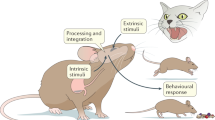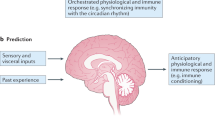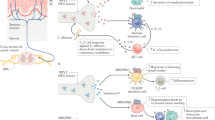Abstract
Many neuropeptides and peptide hormones are very similar to antimicrobial peptides in their amino acid composition, amphipathic design, cationic charge and size. Their antimicrobial activities suggest they may also be directly involved in innate defense. Here we discuss recent advances in understanding how the mammalian nervous system, equipped with neuropeptides and peptide hormones with potent antimicrobial properties, might directly defend the host from microbial assault. As examples, we have chosen five well described, locally produced neuropeptides that may serve a previously unrecognized, direct antimicrobial, innate immune function in four anatomical sites.
This is a preview of subscription content, access via your institution
Access options
Subscribe to this journal
Receive 12 print issues and online access
$209.00 per year
only $17.42 per issue
Buy this article
- Purchase on Springer Link
- Instant access to full article PDF
Prices may be subject to local taxes which are calculated during checkout


Similar content being viewed by others
References
Elenkov, I.J., Wilder, R.L., Chrousos, G.P. & Vizi, E.S. The sympathetic nerve—an integrative interface between two supersystems: the brain and the immune system. Pharmacol. Rev. 52, 595–638 (2000).
Tracey, K.J. The inflammatory reflex. Nature 420, 853–859 (2002).
Nguyen, M.D., Julien, J.P. & Rivest, S. Innate immunity: the missing link in neuroprotection and neurodegeneration? Nat. Rev. Neurosci. 3, 216–227 (2002).
Steinman, L. Elaborate interactions between the immune and nervous systems. Nat. Immunol. 5, 575–581 (2004).
Zasloff, M. Magainins, a class of antimicrobial peptides from Xenopus skin: isolation, characterization of two active forms, and partial cDNA sequence of a precursor. Proc. Natl. Acad. Sci. USA 84, 5449–5453 (1987).
Benson, B.J. & Hadley, M.E. In vitro characterization of adrenergic receptors controlling skin gland secretion in two anurans, Rana pipiens and Xenopus laevis. Comp. Biochem. Physiol. 30, 857–864 (1969).
Simmaco, M., Mignogna, G. & Barra, D. Antimicrobial peptides from amphibian skin: what do they tell us? Biopolymers 47, 435–450 (1998).
Tossi, A. et al. Antimicrobial Sequences Database. <http://www.bbcm.univ.trieste.it/~tossi/pag5.htm> (2005).
Ganz, T. Defensins: antimicrobial peptides of innate immunity. Nat. Rev. Immunol. 3, 710–720 (2003).
Zasloff, M. Antimicrobial peptides of multicellular organisms. Nature 415, 389–395 (2002).
Brogden, K.A., Ackermann, M., McCray, P.B. & Tack, B.F. Antimicrobial peptides in animals and their role in host defences. Int. J. Antimicrob. Agents 22, 465–478 (2003).
Vizioli, J. & Salzet, M. Antimicrobial peptides from animals: focus on invertebrates. Trends Pharmacol. Sci. 23, 494–496 (2002).
Tjabringa, G.S. et al. The antimicrobial peptide LL-37 activates innate immunity at the airway epithelial surface by transactivation of the epidermal growth factor receptor. J. Immunol. 171, 6690–6696 (2003).
Zanetti, M. Cathelicidins, multifunctional peptides of the innate immunity. J. Leukoc. Biol. 75, 39–48 (2004).
Gallo, R.L., Murakami, M., Ohtake, T. & Zaiou, M. Biology and clinical relevance of naturally occurring antimicrobial peptides. J. Allergy Clin. Immunol. 110, 823–831 (2002).
Yang, D. et al. Many chemokines including CCL20/MIP-3α display antimicrobial activity. J. Leukoc. Biol. 74, 448–455 (2003).
Chaly, Y.V. et al. Neutrophil α-defensin human neutrophil peptide modulates cytokine production in human monocytes and adhesion molecule expression in endothelial cells. Eur. Cytokine Netw. 11, 257–266 (2000).
Yang, D., Biragyn, A., Hoover, D.M., Lubkowski, J. & Oppenheim, J.J. Multiple roles of antimicrobial defensins, cathelicidins, and eosinophil-derived neurotoxin in host defense. Annu. Rev. Immunol. 22, 181–215 (2004).
Cole, A.M. et al. Cutting edge: IFN-inducible ELR-CXC chemokines display defensin-like antimicrobial activity. J. Immunol. 167, 623–627 (2001).
Tang, Y.Q., Yeaman, M.R. & Selsted, M.E. Antimicrobial peptides from human platelets. Infect. Immun. 70, 6524–6533 (2002).
Chang, F.Y. et al. Thrombocytopenia in liver transplant recipients: predictors, impact on fungal infections, and role of endogenous thrombopoietin. Transplantation 69, 70–75 (2000).
Maxwell, A.I., Morrison, G.M. & Dorin, J.R. Rapid sequence divergence in mammalian β-defensins by adaptive evolution. Mol. Immunol. 40, 413–421 (2003).
Stolzenberg, E.D., Anderson, G.M., Ackermann, M.R., Whitlock, R.H. & Zasloff, M. Epithelial antibiotic induced in states of disease. Proc. Natl Acad. Sci. USA 94, 8686–8690 (1997).
Hao, H.N., Zhao, J., Lotoczky, G., Grever, W.E. & Lyman, W.D. Induction of human β-defensin-2 expression in human astrocytes by lipopolysaccharide and cytokines. J. Neurochem. 77, 1027–1035 (2001).
Nakayama, K., Okamura, N., Arai, H., Sekizawa, K. & Sasaki, H. Expression of human β-defensin-1 in the choroid plexus. Ann. Neurol. 45, 685 (1999).
Couillault, C. et al. TLR-independent control of innate immunity in Caenorhabditis elegans by the TIR domain adaptor protein TIR-1, an ortholog of human SARM. Nat. Immunol. 5, 488–494 (2004).
Lundy, F.T. & Linden, G.J. Neuropeptides and neurogenic mechanisms in oral and periodontal inflammation. Crit. Rev. Oral Biol. Med. 15, 82–98 (2004).
Scholzen, T. et al. Neuropeptides in the skin: interactions between the neuroendocrine and the skin immune systems. Exp. Dermatol. 7, 81–96 (1998).
Lever, I.J. et al. Basal and activity-induced release of substance P from primary afferent fibres in NK1 receptor knockout mice: evidence for negative feedback. Neuropharmacology 45, 1101–1110 (2003).
Pinter, E., Than, M., Chu, D.Q., Fogg, C. & Brain, S.D. Interaction between interleukin 1β and endogenous neurokinin 1 receptor agonists in mediating plasma extravasation and neutrophil accumulation in the cutaneous microvasculature of the rat. Neurosci. Lett. 318, 13–16 (2002).
Olerud, J.E. et al. Neutral endopeptidase expression and distribution in human skin and wounds. J. Invest. Dermatol. 112, 873–881 (1999).
Kowalska, K., Carr, D.B. & Lipkowski, A.W. Direct antimicrobial properties of substance P. Life Sci. 71, 747–750 (2002).
Kennedy, W.R., Wendelschafer-Crabb, G. & Johnson, T. Quantitation of epidermal nerves in diabetic neuropathy. Neurology 47, 1042–1048 (1996).
National Diabetes Advisory Board. NIH Publication 81:2284. (National Diabetes Advisory Board, Bethesda, Maryland, 1980).
Gibran, N.S. et al. Diminished neuropeptide levels contribute to the impaired cutaneous healing response associated with diabetes mellitus. J. Surg. Res. 108, 122–128 (2002).
Dale, B.A. et al. Localized antimicrobial peptide expression in human gingiva. J. Periodontal Res. 36, 285–294 (2001).
Kido, M.A., Yamaza, T., Goto, T. & Tanaka, T. Immunocytochemical localization of substance P neurokinin-1 receptors in rat gingival tissue. Cell Tissue Res. 297, 213–222 (1999).
Lotz, M., Vaughan, J.H. & Carson, D.A. Effect of neuropeptides on production of inflammatory cytokines by human monocytes. Science 241, 1218–1221 (1988).
Sabbadini, E. & Berczi, I. The submandibular gland: a key organ in the neuro-immuno-regulatory network? Neuroimmunomodulation 2, 184–202 (1995).
Mathews, M. et al. Production of β-defensin antimicrobial peptides by the oral mucosa and salivary glands. Infect. Immun. 67, 2740–2745 (1999).
Putsep, K., Carlsson, G., Boman, H. & Andersson, M. Deficiency of antibacterial peptides in patients with morbus Kostmann: an observation study. Lancet 360, 1144–1149 (2002).
Shimizu, M., Shigeri, Y., Tatsu, Y., Yoshikawa, S. & Yumoto, N. Enhancement of antimicrobial activity of neuropeptide Y by N-terminal truncation. Antimicrob. Agents Chemother. 42, 2745–2746 (1998).
Wu, Q. et al. Developmental control of foraging and social behavior by the Drosophila neuropeptide Y-like system. Neuron 39, 147–161 (2003).
Bedoui, S. et al. Relevance of neuropeptide Y for the neuroimmune crosstalk. J. Neuroimmunol. 134, 1–11 (2003).
Hansel, D.E., Eipper, B.A. & Ronnett, G.V. Neuropeptide Y functions as a neuroproliferative factor. Nature 410, 940–944 (2001).
Ubink, R., Calza, L. & Hokfelt, T. 'Neuro'-peptides in glia: focus on NPY and galanin. Trends Neurosci. 26, 604–609 (2003).
Ubink, R. & Hokfelt, T. Expression of neuropeptide Y in olfactory ensheathing cells during prenatal development. J. Comp. Neurol. 423, 13–25 (2000).
Fukushi, H. et al. A hamster model of equine herpesvirus 9 induced encephalitis. J. Neurovirol. 6, 314–319 (2000).
Barthold, S.W. Olfactory neural pathway in mouse hepatitis virus nasoencephalitis. Acta Neuropathol. (Berl.) 76, 502–506 (1988).
van Ginkel, F.W. et al. Pneumococcal carriage results in ganglioside-mediated olfactory tissue infection. Proc. Natl. Acad. Sci. USA 100, 14363–14367 (2003).
Andrault, J.B., Gaillard, I., Giorgi, D. & Rouquier, S. Expansion of the BPI family by duplication on human chromosome 20: characterization of the RY gene cluster in 20q11.21 encoding olfactory transporters/antimicrobial-like peptides. Genomics 82, 172–184 (2003).
Bingle, C.D. et al. Phylogenetic and evolutionary analysis of the PLUNC gene family. Protein Sci. 13, 422–430 (2004).
Elsbach, P. & Weiss, J. Role of the bactericidal/permeability-increasing protein in host defence. Curr. Opin. Immunol. 10, 45–49 (1998).
Sung, Y.K. et al. Plunc, a member of the secretory gland protein family, is up-regulated in nasal respiratory epithelium after olfactory bulbectomy. J. Biol. Chem. 277, 12762–12769 (2002).
Vouldoukis, I., Shai, Y., Nicolas, P. & Mor, A. Broad spectrum antibiotic activity of the skin-PYY. FEBS Lett. 380, 237–240 (1996).
Eto, T., Kato, J. & Kitamura, K. Regulation of production and secretion of adrenomedullin in the cardiovascular system. Regul. Pept. 112, 61–69 (2003).
Cameron, V.A. & Fleming, A.M. Novel sites of adrenomedullin gene expression in mouse and rat tissues. Endocrinology 139, 2253–2264 (1998).
Martinez, A., Hodge, D.L., Garayoa, M., Young, H.A. & Cuttitta, F. Alternative splicing of the proadrenomedullin gene results in differential expression of gene products. J. Mol. Endocrinol. 27, 31–41 (2001).
McLatchie, L.M. et al. RAMPs regulate the transport and ligand specificity of the calcitonin-receptor-like receptor. Nature 393, 333–339 (1998).
Born, W., Muff, R. & Fischer, J.A. Functional interaction of G protein-coupled receptors of the adrenomedullin peptide family with accessory receptor-activity-modifying proteins (RAMP). Microsc. Res. Tech. 57, 14–22 (2002).
Zaks-Zilberman, M., Salkowski, C.A., Elsasser, T., Cuttitta, F. & Vogel, S.N. Induction of adrenomedullin mRNA and protein by lipopolysaccharide and paclitaxel (Taxol) in murine macrophages. Infect. Immun. 66, 4669–4675 (1998).
Allaker, R.P., Zihni, C. & Kapas, S. An investigation into the antimicrobial effects of adrenomedullin on members of the skin, oral, respiratory tract and gut microflora. FEMS Immunol. Med. Microbiol. 23, 289–293 (1999).
Kapas, S. et al. Adrenomedullin expression in pathogen-challenged oral epithelial cells. Peptides 22, 1485–1489 (2001).
Allaker, R.P. & Kapas, S. Adrenomedullin and mucosal defence: interaction between host and microorganism. Regul. Pept. 112, 147–152 (2003).
Marutsuka, K. et al. Adrenomedullin and proadrenomudullin N-terminal 20 peptide (PAMP) are present in human colonic epithelia and exert an antimicrobial effect. Exp. Physiol. 86, 543–545 (2001).
Muller, F.B. et al. Adrenomedullin: expression and possible role in human skin and hair growth. Br. J. Dermatol. 148, 30–38 (2003).
Martinez, A. et al. Expression of adrenomedullin and its receptor in normal and malignant human skin: a potential pluripotent role in the integument. Endocrinology 138, 5597–5604 (1997).
Lundy, F.T. et al. Adrenomedullin in gingival crevicular fluid in periodontal health and disease. J. Dent. Res. 80, 1176 (2001).
Elsasser, T.H. et al. Underlying disease stress augments plasma and tissue adrenomedullin (AM) responses to endotoxin: colocalized increases in AM and inducible nitric oxide synthase within pancreatic islets. Endocrinology 140, 5402–5411 (1999).
Cutuli, M., Cristiani, S., Lipton, J.M. & Catania, A. Antimicrobial effects of α-MSH peptides. J. Leukoc. Biol. 67, 233–239 (2000).
Wikberg, J.E. et al. New aspects on the melanocortins and their receptors. Pharmacol. Res. 42, 393–420 (2000).
Taylor, A.W., Yee, D.G., Nishida, T. & Namba, K. Neuropeptide regulation of immunity. The immunosuppressive activity of α-melanocyte-stimulating hormone (α-MSH). Ann. NY Acad. Sci. 917, 239–247 (2000).
Catania, A., Airaghi, L., Colombo, G. & Lipton, J.M. α-melanocyte-stimulating hormone in normal human physiology and disease states. Trends Endocrinol. Metab. 11, 304–308 (2000).
Getting, S.J. Melanocortin peptides and their receptors: new targets for anti-inflammatory therapy. Trends Pharmacol. Sci. 23, 447–449 (2002).
Lipton, J.M., Catania, A. & Ichiyama, T. Marshaling the anti-inflammatory influence of the neuroimmunomodulator α-MSH. News Physiol. Sci. 15, 192–195 (2000).
Ichiyama, T., Sato, S., Okada, K., Catania, A. & Lipton, J.M. The neuroimmunomodulatory peptide α-MSH. Ann. NY Acad. Sci. 917, 221–226 (2000).
Chakraborty, A.K. et al. UV light and MSH receptors. Ann. NY Acad. Sci. 885, 100–116 (1999).
Bayerl, C., Lauk, J., Moll, I. & Jung, E.G. Immunohistochemical characterization of HSP, α-MSH, Merkel cells and neuronal markers in acute UV dermatitis and acute contact dermatitis in vivo. Inflamm. Res. 46, 409–411 (1997).
Luger, T.A., Scholzen, T.E., Brzoska, T. & Bohm, M. New insights into the functions of α-MSH and related peptides in the immune system. Ann. NY Acad. Sci. 994, 133–140 (2003).
Salzet, M. & Tasiemski, A. Involvement of pro-enkephalin-derived peptides in immunity. Dev. Comp. Immunol. 25, 177–185 (2001).
Metz-Boutigue, M.H., Kieffer, A.E., Goumon, Y. & Aunis, D. Innate immunity: involvement of new neuropeptides. Trends Microbiol. 11, 585–592 (2003).
Behar, O., Ovadia, H., Polakiewicz, R.D. & Rosen, H. Lipopolysaccharide induces proenkephalin gene expression in rat lymph nodes and adrenal glands. Endocrinology 134, 475–481 (1994).
Sharp, B.M., Roy, S. & Bidlack, J.M. Evidence for opioid receptors on cells involved in host defense and the immune system. J. Neuroimmunol. 83, 45–56 (1998).
Machelska, H. & Stein, C. Pain control by immune-derived opioids. Clin. Exp. Pharmacol. Physiol. 27, 533–536 (2000).
Hook, V.Y. et al. Evidence for functional localization of the proenkephalin-processing enzyme, prohormone thiol protease, to secretory vesicles of chromaffin cells. Endocrinology 140, 3744–3754 (1999).
Goumon, Y. et al. Characterization of antibacterial COOH-terminal proenkephalin-A-derived peptides (PEAP) in infectious fluids. Importance of enkelytin, the antibacterial PEAP209–237 secreted by stimulated chromaffin cells. J. Biol. Chem. 273, 29847–29856 (1998).
Lugardon, K. et al. Antibacterial and antifungal activities of vasostatin-1, the N-terminal fragment of chromogranin A. J. Biol. Chem. 275, 10745–10753 (2000).
Lugardon, K. et al. Structural and biological characterization of chromofungin, the antifungal chromogranin A(47–66)-derived peptide. Ann. NY Acad. Sci. 971, 359–361 (2002).
Strub, J.M. et al. Processing of chromogranin B in bovine adrenal medulla. Identification of secretolytin, the endogenous C-terminal fragment of residues 614–626 with antibacterial activity. Eur. J. Biochem. 229, 356–368 (1995).
Tasiemski, A. et al. Presence of chromogranin-derived antimicrobial peptides in plasma during coronary artery bypass surgery and evidence of an immune origin of these peptides. Blood 100, 553–559 (2002).
Mor, A., Amiche, M. & Nicolas, P. Structure, synthesis, and activity of dermaseptin b, a novel vertebrate defensive peptide from frog skin: relationship with adenoregulin. Biochemistry 33, 6642–6650 (1994).
Bateman, A. et al. The isolation and characterization of a novel corticostatin/defensin-like peptide from the kidney. J. Biol. Chem. 271, 10654–10659 (1996).
Acknowledgements
We thank M. Marti for preparation of the figures. Supported by the National Institute of Dental and Craniofacial Research (1 R01 DE014390-01A2), National Institutes of Health (K.A.B.) and the Centre National de la Recherche Scientifique, Ministére de la Recherche et des Technologies, National Institutes of Health–Forgarty, Fondation pour la Recherche Médicale and Génopole-Lille (M.S.).
Author information
Authors and Affiliations
Corresponding author
Ethics declarations
Competing interests
The authors declare no competing financial interests.
Rights and permissions
About this article
Cite this article
Brogden, K., Guthmiller, J., Salzet, M. et al. The nervous system and innate immunity: the neuropeptide connection. Nat Immunol 6, 558–564 (2005). https://doi.org/10.1038/ni1209
Published:
Issue Date:
DOI: https://doi.org/10.1038/ni1209
This article is cited by
-
Transcriptome analysis reveals the activation of neuroendocrine-immune system in shrimp hemocytes at the early stage of WSSV infection
BMC Genomics (2019)
-
Subclinical lipopolysaccharide from Salmonella Enteritidis induces neuropeptide dysregulation in the spinal cord and the dorsal root ganglia
BMC Neuroscience (2019)
-
Evaluation of the virulence of entomopathogenic fungus, Isaria fumosorosea isolates against subterranean termites Coptotermes spp. (Isoptera: Rhinotermitidae)
Journal of Forestry Research (2019)
-
Phosphopeptidomics Reveals Differential Phosphorylation States and Novel SxE Phosphosite Motifs of Neuropeptides in Dense Core Secretory Vesicles
Journal of the American Society for Mass Spectrometry (2018)
-
A secreted antibacterial neuropeptide shapes the microbiome of Hydra
Nature Communications (2017)



